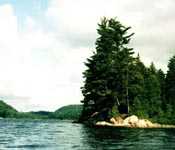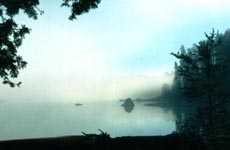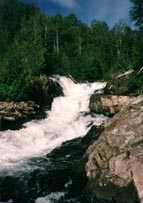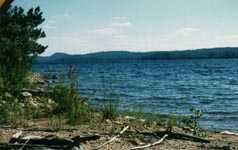From Nastawgan ![]()
OK, so you have paddled the Spanish River several times, love it for its wilderness feel, its symphony of white water and exhilarating rapids, all within half a day's drive from Toronto. But you are getting a bit tired of it, "been there, done it!" and are looking for other places. Let me suggest that you go back and do a detour that will lead you through the land beyond the river shore, a land that Grey Owl talked about in "The Men of the Last Frontier" and that you may yet explore. Consider that the native Anishnabe have lived there for centuries, travelling up and down the river to the rhythm of the seasons in order to reach the places where they would hunt and fish. Their routes are still there, and with a little extra effort, you will find them. Enjoy the beauty of this back country, put the old portages to use and reclaim the routes for the canoe, before loggers and miners claim it as theirs. Here's a sampler:
|
The waterfall above the flume |
To get to the Spanish, you could jump on the VIA train in Cartier (check the schedules, as the trains run only on alternate days) and ask to be left out at the "flume". Another way is to start from Duke Lake and begin with the East Branch as written up in "Canoeing Ontario's Rivers" Ron Reid and Janet Grand. You could also come from further up, possibly as far as Biscotasing via the Spanish River West Branch. At the "flume", about 10 km below the point where the east and west branches of the Spanish come together, a small river enters from the right, the Pogomasing River. Portage up the well defined trail on the north shore for about 800m, to Pogomasing Lake, or Pog', for short. It's a pretty portage, with the old logging flume to your left, each year less recognizable for its original purpose. Carry past the little pond and then up the hill, past a rushing water fall and put into the lake, right at the still maintained dam |
. (Note: since 1997, the portage has suffered from blow-downs. As you pass through, please have your saw handy and clear out ONE obstacle for the folks behind you. Maybe we'll get it back in shape that way. Also, I have gotten feedback that the flume portage should be considered strenuous for parties with large and heavy canoes. Such groups should consider portaging via the trail that is used by the cottage community. It starts 3 km downstream from the flume and leaves from the shore opposite the Sheahan train stop. It is slightly longer and a bit boring, but is wide and has no steep grades. If you come by train, get to it by having yourself dropped off at the rail bridge over the Spanish and paddle downstream to the portage. Its hard to miss as there are usually cottagers' boats lying on both shores.)
| Pog' Lake is large, not quite 20 km long, and waves can build up quickly. You will want to head south on this lake, but if you should consider a visit to the north end, there is a large campsite on Picnic Island in the northern end of the lake. Other good sites are: right at the sand spit where you entered Pog' Lake; then 3 km south on the western side at the north shore of the bay where the Pogomasing River enters the lake (take care not to trespass onto private land that is nearby); and there are a few suitable sand beaches in the middle and southern parts of the lake. You will travel to the south, but if you have time to spare, you could make a further side trip up the Pog' River into Little Pog', Dennis |
|
and Gilden Lakes and then to Sinaminda Lake. I have seen moose and bald eagles on such an excursion and found it well worth while. Pog' itself had a Hudson's Bay post on Kingston's island. It is probably the one where Grey Owl's friend, Alex Espaniel, was born. As Grey Owl was trapping in the area during two winters in the early 1920's, he very likely was familiar with this old Bay post. Today, there is nothing left of its buildings: I am told they were razed when the last factor's wife had died. (1)
To continue your trip, head into the narrow southwest bay of Pog' Lake (called Dunlop Bay), and locate the portage on the left shore, within about 150 m from the end of the bay. It's a long, but mostly level carry of about 1200m through mature forest. Look for grouse beside the trail, and moose tracks where the soil is soft. As the trail dips at its end, you are on the shore of Kennedy Lake. This lake consists of an oblong northern end about 3 km in length (with a camp site on its north-western beach), and a narrow southern arm, 5 km long, filling an old geological fault. You will love its clean waters and steep cliffs that rise several hundred feet above the waters. Look for loons at the first large rock face, calling and then answering their own echo as it bounces back from the wall.
The southern end of this lake is blocked by a leaky old logging dam, and the 50m portage takes you into a chain of small lakes without names, connected by the gentle flow of the Mogo River. If you want to camp, there is a small camp site on the eastern shore, about 1.5 km south of the Kennedy Dam. After a total of 4 km, you enter Blue Water Lake.
 |
Lake is surrounded by dark boreal forest on sandy and gravely shores; there is logging activity beyond the forest wall. You may even hear the distant clank of machinery and muted engine roar from over the hill on the north-western end. The southern end of the lake contains an anomaly you would not expect in this part of the country: a tight circular bay that is blue, as if this were Killarney. The clear water is without weeds and, on a calm day, you can see maybe 50 ft down and look at the submerged tree trunks as if you were floating in an aqarium. |
If you decide to swim, be ready for a shock: I have measured the water temperature at 14 degrees Celsius, four feet from shore, in mid-August. There is a camp site right in the bay, where someone has assembled beams into a structure that seems to serve as the frame for a camp during the fall hunting season.
Just to the north of this bay, the Mogo River leaves the lake, meanders past a wide marsh, then is blocked by a log jam that can easily be clambered across at its left side. Next, the river is squeezed by the narrowing hills on both sides; it's time to portage down towards the Spanish River. The following two portages are rough and their start is hard to locate. I have talked to local folks and they confirmed that the portages were used years back. Today, where the float plane is the usual method of access to the remote lakes, there seems little use for them. I have seen no indication that anyone has been across them this season yet. But the blazes are still there and I have placed portage markers at the beginning of the first two portages. None of the portages are runnable and you will not be able to avoid the carry.
The portage that bypasses the first water fall starts on the right shore, right at the brink of the falls, and has a length of about 400m. Put back into the water and paddle for about 200m until you come to a small falls with an excellent camp site (3 tents).
There is a short paddle (200m) until the next portage, on the right, and you could use its start as a small camp site. The portage is about 250m long, and ends where the creek from Loon Lake enters from the right. A 1-km paddle and you are at the start of the next portage. Look for the remnants of what could have been a logging dam, a pile of rocks on the right shore. The river beyond this point requires frequent lining which gets progressively worse until you are stuck in a deep valley with falls and impassable shores. Thus, it is advisable to pull out at the start of this portage, on the right shore, and forsake the lining. The trail is about 1200m long, but it has been in use lately and is easy to walk. It ends where the Mogo spills into the Spanish, in the back yard of a cabin. Remember to be polite, as you are on private property.
Now you are back on the Spanish, about 6 km above Spanish Lake. To end the trip, you could pull out at the Elbow and ask the folks at Fox Lake Lodge (area code 705, 965-2701) for a shuttle back to Cartier's railway station, or continue beyond the Graveyard Rapids down to Agnew Lake.
![]() Map of the portages on the Mogo River
Map of the portages on the Mogo River
© Her Majesty the Queen in Right of Canada,
reproduced with permission from Natural Resources Canada
 |
Scarborough, September 5, 1997 Erhard Kraus |
Note (1): In "Land of the Shadows", Grey Owl's biography by Donald S. Smith, is the following reference:
In Bisco, Archie's best friends were the Espaniels, or L'Espagnols (French for "Spaniards"), an Ojibwa family with whom he lived for several years in the early 1920s. He considered Alex Espaniel as "a kind of adopted father
of mine" and, in many respects, Alex was the only real father Archie ever had. Alex's son Jim, and Jane, his younger daughter became Archie's lifelong friends. Alex's father Louis Espaniel, had run a small HBC outpost
at Pogamising, just east of Bisco. Louis' grandfather the original LEspagnol, or "Spaniard" in some ways had been a
late-eighteenth-century Spanish equivalent of Archie Belaney, a white man who had adopted an Indian
lifestyle. The Spanish adventurer had joined the Ojibwa around the post of La Cloche, on the north shore of Lake Huron, after the British Conquest. He married a local Indian woman and came to lead her band. Alex was born at Pogamising on Christmas Day, 1870. Anxious that he secure a good education, Louis sent him to a Roman Catholic
boarding school in Montreal. Alex studied in French and to the end of his days in Bisco loved to read Montreal's La Presse. A good trapper he also guided and prospected.
A generous man, he was always buying food for someone or paying for someone to go to the hospital. He welcomed Archie into his home. Alex's wife, Anny, and the Espaniels' six children found Archie excellent company. Anny Nootchal Espaniel had been raised at the Whitefish Reserve near Sudbury and as a young woman had worked as the housekeeper for several of Sudbury's doctors. Like her husband, she knew the non-Indian world well.
Archie stayed with the Espaniels for two or three years and joined them for two winters at their trapping ground at Indian Lake on the east branch of the Spanish River just above Archie's hunting ground at Mozhabong
Lake. In one of his notebooks Archie paid Alex this compliment: "Early days everything speedy, rip tearing speed. After I met Alex Spaniel more calm & quiet contentment, little intimate enjoyments, the appreciation of the woods in its fuller sense". From the Espaniels, Archie learned the "Indian way of doing things"....
Disclaimer
The advice provided in Spanish River Side Trip, by Erhard has been compiled based upon 30 years experience canoeing in Ontario. Every effort has been made to ensure that the advice in this web site is correct. Even so, I do not accept any responsibility for errors or misrepresentations contained herein.
WARNING! This advice is intended for use by those with some prior experience in camping, canoe-tripping and backpacking. I do not assume responsibility for the safety of individuals, nor do I accept liability for any loss or damages that might arise in the course of following the advice presented in this web site.















 Lake Pogomasing (Photo by Peggy)
Lake Pogomasing (Photo by Peggy)